Caring for Australian Native Flowers
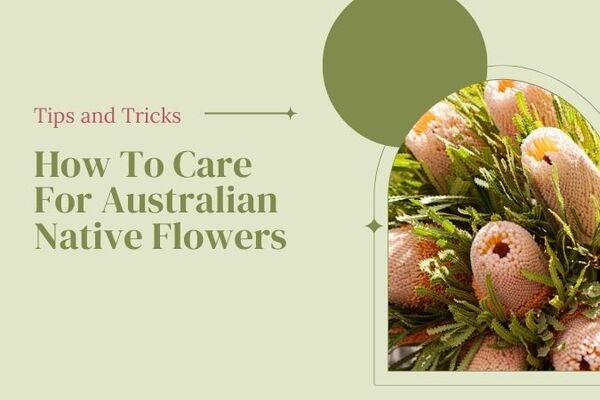
Australia is home to some incredibly unique and beautiful native flowers. From vibrant grevilleas to delicate waxflowers, our endemic blooms showcase the diversity of our landscapes. Looking after these eye-catching plants requires some specific care and attention to maintain their freshness and longevity as cut flowers or garden specimens. This guide covers simple tips for nurturing some of our most popular native blossoms.
Lily's Florist offers an extensive range of vibrant and beautiful Australian native flowers for same day flower delivery across Australia. All our flowers are carefully handled by expert partner florists to ensure freshness, quality and longevity. We have competitive prices and same-day Australia-wide delivery make it easy to send these floral gifts for any occasion while supporting local growers. Explore the versatile beauty of native Australian flowers with Lily's Florist.
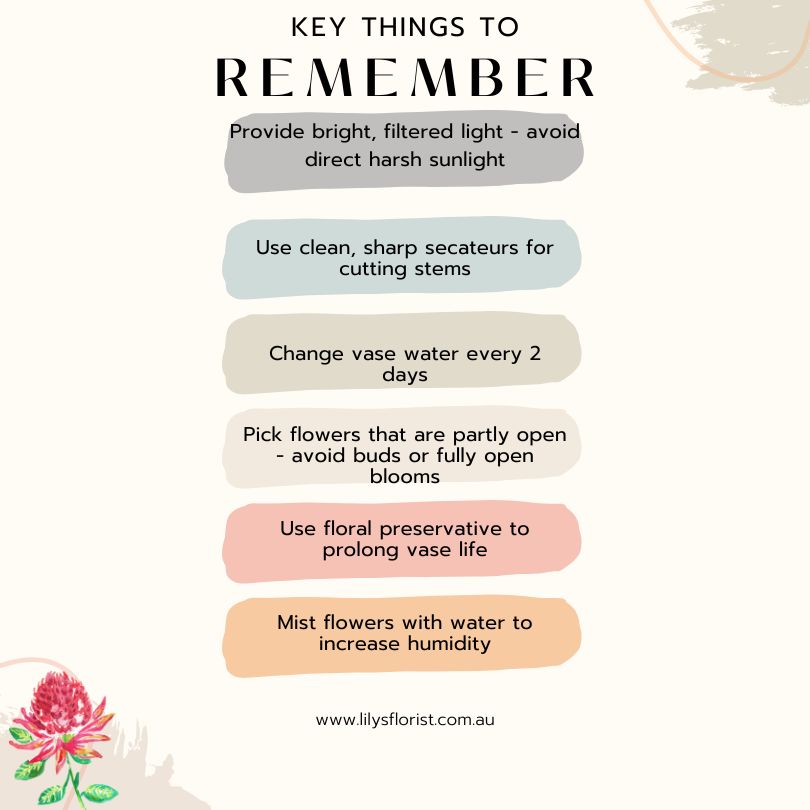
Caring for Popular Australian Native Flowers
From grevilleas to gum blossoms, here are some specifics for looking after some of Australia’s most recognisable flowers:
Grevilleas
Grevilleas are extremely versatile Australian native plants. These evergreen shrubs produce vibrant, toothbrush-like flower spikes in shades of red, pink, orange and yellow.
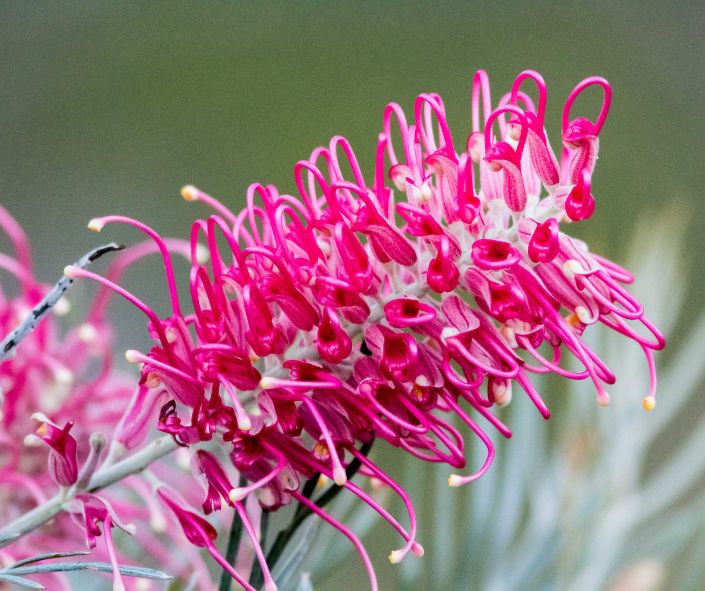
Popular Grevillea varieties for cut flower arrangements include:
- Grevillea 'Superb' - dense, dramatic spikes with red and yellow flowers
- Grevillea 'Pink Surprise' - delicate light pink and white spider flowers on slim stems
- Grevillea johnsonii - deeply cut, fine-textured grey foliage with red toothbrush blooms
- Grevillea victoriae (Royal Grevillea) - large, erect orange flower racemes
- Water Needs - Upon harvest, place Grevillea stems immediately into tepid water. Recut 2cm from the base of stems every few days, replace vase water daily and use floral preservative solution.
Among the most prolific flowering native plants, Grevilleas are also important nectar producers for birds and insects. These versatile shrubs are widely cultivated in home gardens across Australia. Many species are threatened in the wild due to habitat loss.
- Light & Humidity - Filtered light allows the best display of Grevillea arrangements indoors by prolonging flower life. Avoid placing vases in full sun or near heating outlets that dehydrate blooms. Light misting can boost moisture for delicate flowers.
- Flower Care - Carefully strip away lower leaves from harvested Grevillea stems before placing in water to reduce microbial growth in solutions. Cut stems on a sharp diagonal and change water daily for longest vase life of around 21 days.
Pro Tip:
Use a clean, sharp cut at an angle on stems to maximize water uptake and longevity for Grevillea arrangements.
Waratahs
With their bold, showy red flower heads, New South Wales' floral emblem makes a stunning cut flower. Waratahs showcase the beauty and diversity of Australia's native flora.
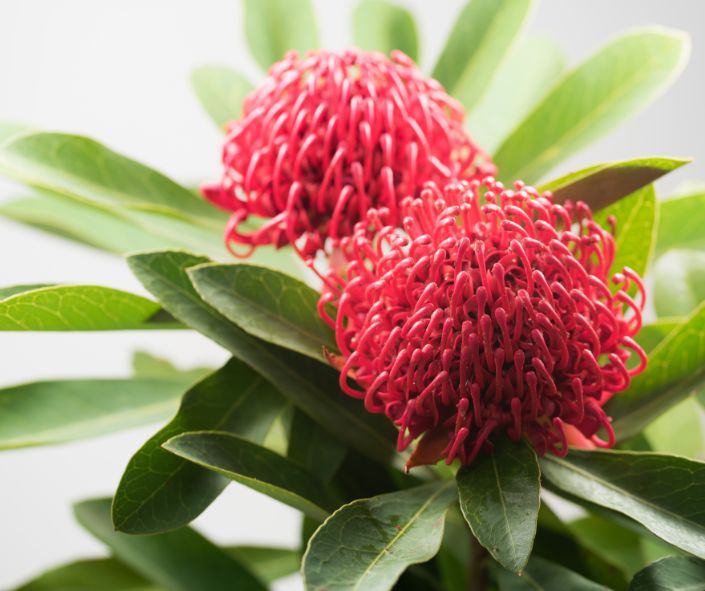
- Choosing Waratahs - Pick stems with half to two-thirds of the flowers on the head open. Fully open or tightly closed flower heads will have shorter vase life. Look for bright, unblemished blooms.
- Conditioning Stems - After harvest, plunge Waratah stems immediately into warm water around 100°F/38°C and allow them to rehydrate for at least 4 hours. Use clean secateurs and make a fresh cut at the base of stems before placing into floral arrangements.
Waratahs thrive in rocky soils and full sun. These striking flowers have inspired artists and appearing in Indigenous Australian legends. Waratah's botanical name Telopea derives from the Greek words telopos meaning "seen from afar" and ops meaning eye. This aptly describes the attention these scarlet flower heads command.
- Caring for Cut Waratahs - Take care not to bruise delicate Waratah blooms when arranging stems. Display arrangements away from direct sunlight to prolong their life. Top up clean vase water daily and recut stems every 2-3 days.
- Additives - Commercial floral preservative helps nurture cut Waratah flowers. Alternatively, add lemon juice or vinegar to acidify vase water. Drop an alka seltzer tablet into the vase every few days to provide carbon dioxide fertilization.
Pro Tip:
Waratahs flower heads should be inspected daily and old florets removed to improve appearance and encourage new buds.
Banksias
The large, brush-like flower spikes of Banksia plants last well as cut flowers. These iconic Australian natives come in a wide range of forms.
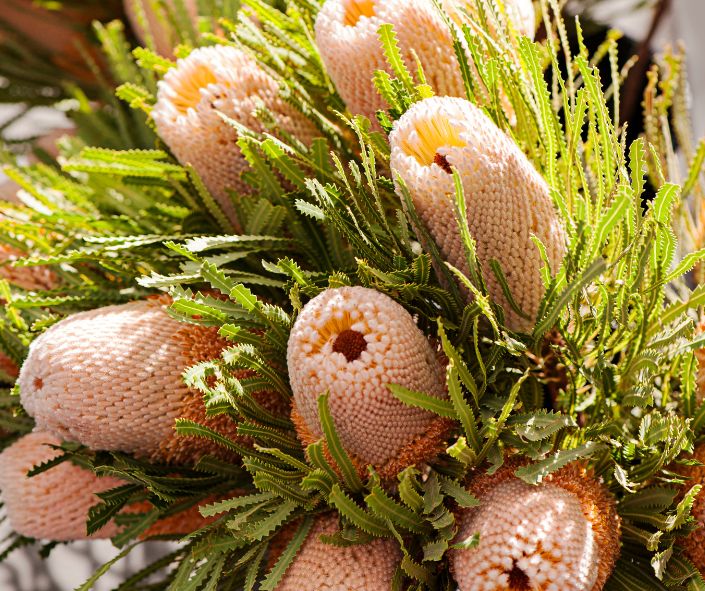
- Popular Varieties - Common banksia varieties used as cut flowers include Banksia ashbyi (Ashby's Banksia), Banksia baxteri, Banksia coccinea (Scarlet Banksia), Banksia hookeriana (Hooker's Banksia), Banksia integrifolia (Coast Banksia) and Banksia sceptrum (Sceptre Banksia).
Banksias grow wild across Australia’s east coast, from Queensland down to Victoria and also Western Australia. They favor well-drained, sandy soils and bloom after bushfires. Banksias feature prominently in Australian art for their beauty and as symbols of resilience.
- Harvest Time - Pick Banksia stems for floral arrangements when individual florets on the flower spikes begin to open, but before pollen is released. Late bud stage is ideal. Use clean, sharp secateurs or garden snips when gathering stems.
- Conditioning - Take care not to crush woody Banksia stems. Split or scrape a small section at the base of each stem before placing into warm water for several hours of rehydration. Recut stems and replace water prior to arranging.
- Caring Tips - Display Banksia arrangements out of direct sun. Top up vase water at least every other day and recut stems whenever water is changed to maintain uptake. Lightly mist flowers to boost humidity around botanicals.
Pro Tip:
Gently wash dust off Banksia flower spikes to regain their full visual impact in arrangements. Dry thoroughly before redisplaying.
Gum Blossoms
The flower buds of eucalyptus and corymbia trees open into fluffy blossoms, which make long-lasting cut flowers. These generously-sized botanicals add beautiful floral impact.
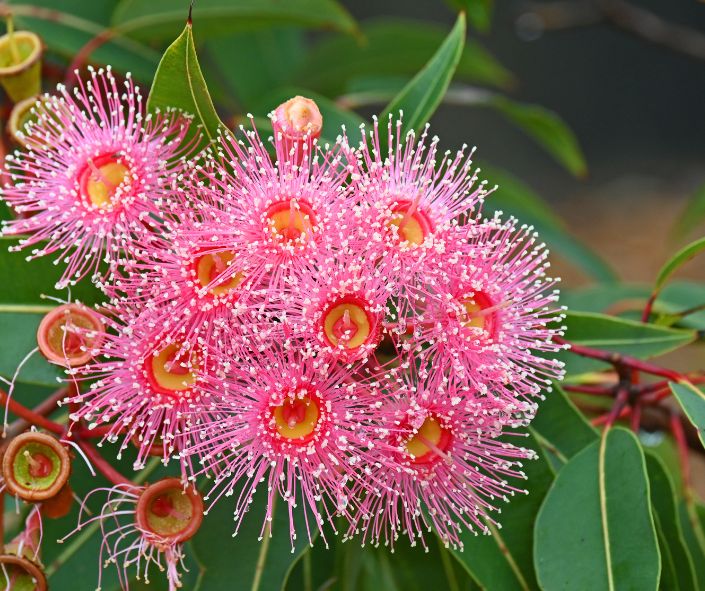
Popular varieties for cut flower use include:
- Corymbia ficifolia (red flowering gum)
- Eucalyptus leucoxylon (yellow gum)
- Eucalyptus macrocarpa (mottlecah)
- Corymbia eximia (yellow bloodwood)
- Harvest Stage - Pick gum tree stems when flower buds are rounded and plump, but haven't yet opened. Use sterile, bypass-action pruners to carefully cut branches without crushing.
Gum blossoms hold an esteemed place in Australian arts and crafts. Their images adorn homewares as symbols of the Australian bush. Gum leaves and flowers appear extensively on currency, stamps and coats of arms to represent our native landscapes.
- Conditioning - Place harvested stems in tepid water around 100°F/38°C for at least a few hours. Soaking allows woody stems to rehydrate after cutting before arranging in vases.
- Caring & Handling - Take care not to overcrowd gum blossom arrangements. Display vases away from heating and cooling vents. Vase life exceeds 2 weeks with daily water replacements and keeping stems in prime condition.
Let iconic Australian gum blossoms infuse your floral designs with natural artistry, for impressive gift giving or home decoration. Their distinctive forms gracefully embody our native wilderness.
Pro Tip:
Re-cut woody gum blossom stems weekly and update water to prolong the attractive floral display.
Waxflowers
Delicate waxflowers produce abundant clusters of small, star-shaped blossoms on slender stems. These dainty Australian wildflowers bring charming textures to arrangements.
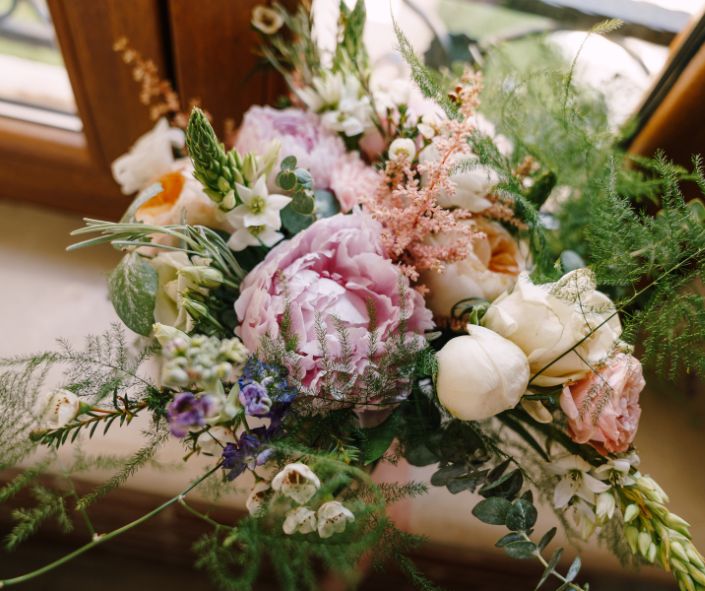
- Popular waxflower varieties include Chamelaucium uncinatum (Geraldton wax), Verticordia nitens (Morrison waxflower), Chamelaucium megalopetalum (large waxflower), and Philotheca myoporoides (long-leaf waxflower).
Waxflowers bloom in late winter and spring in a spectrum of white, pink and purple hues. Named for their waxy flower petals, they grow across southern Australia from South Australia to New South Wales.
- Harvest & Handle Carefully - Use extremely sharp floral scissors or snips when gathering waxflower stems, taking care not to crush delicate blooms and foliage. Gently wrap stems in damp paper after cutting to avoid bruising during transport.
- Conditioning - Place waxflowers straight into tepid water immediately after harvest before arranging. Use floral preservative and replace vase solution every 2 days to nourish these ephemeral blooms.
Arrange waxflowers soon after cutting for maximum enjoyment indoors. Display out of direct sunlight in a cool spot to extend their delicacy. Lightly misting flowers boosts humidity for longer appreciation of their fragile beauty.
- Let dainty waxflowers blossoms be a tactile focus in your home or hand-tied bouquets with their abundant, tissue-paper thin petals. With excellent care, waxflowers may delight for up to 2 weeks.
Pro Tip:
Re-cut woody gum blossom stems weekly and update water to prolong the attractive floral display.
Getting the Most out of Native Flowers
Follow these extra tips for keeping Australian native flowers looking their best for longer:
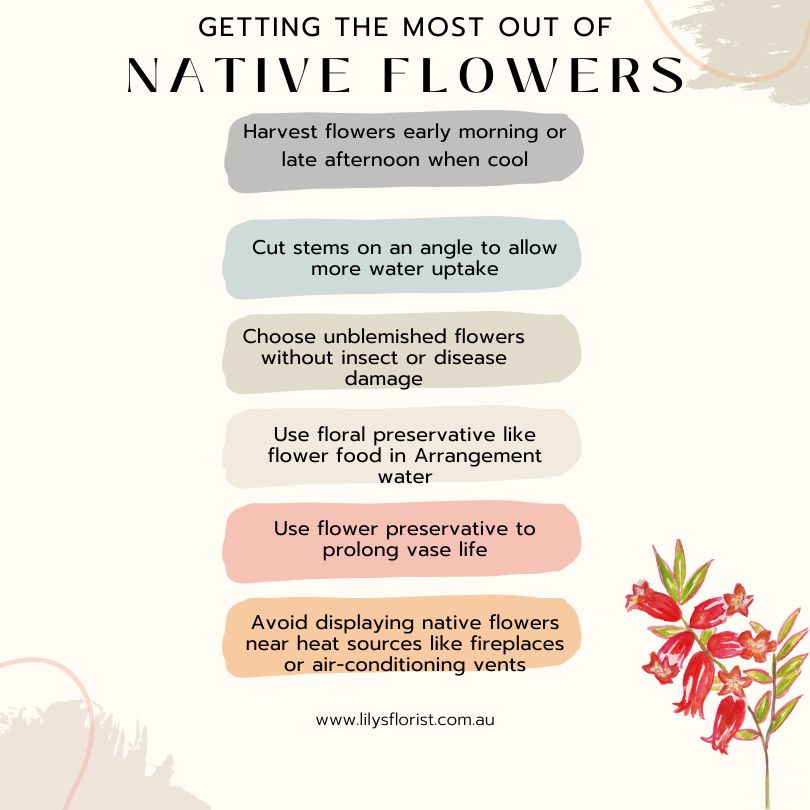
Caring for Popular Australian Native Flowers In Pots
Caring for potted Australian native flowers requires some specific considerations to keep these resilient plants thriving. While adaptable to various conditions, create an optimal potting environment and your flowering natives will reward you with their vibrant beauty.
- Match the potting mix to the native plant's preferences. Most appreciate free-draining soil blends containing compost and materials like perlite or sand to prevent waterlogging.
Kangaroo paws favour a soil pH around 6.5-7, while banksias and grevilleas tolerate more acidic mixes down to pH 5.5. Be guided by the plant requirements. pH-balanced native potting mixes are readily available.
- Allow enough pot depth and width for growth. Plant waxflowers and delicate blooms in narrow pots around 15-30cm wide. Larger shrubs like callistemon suit wider 40-50cm containers. Upgrade pot sizes as the native plant matures.
- Position pots advantageously to provide suitable light levels. Full sun lovers like banksias and waratahs are content in exposed courtyard areas. Shelter subtropical natives and flowers in partly shaded spots protected from harsh afternoon rays.
- Water thoroughly then allow pots to partly dry out before rewetting. Natives dislike constantly sodden soil. Check moisture below the surface using a finger before watering again. During heat waves, increase frequency.
- Apply controlled-release fertilisers or low-phosphorous liquid feeds every few months during the growing seasons. Avoid overfeeding as excessive nutrients can accumulate in potting soil.
Caring for Popular Australian Native Flowers In Winter
The colder months of winter bring different conditions for nurturing Australian native blooms. While some enter dormancy, certain hardy natives continue flowering cheerfully enhancing winter gardens. Adjusting care provides needed support through harsher weather.
- Protect more delicate natives like waxflowers from heavy frost and freezing winds. Move potted plants to sheltered patio areas or under verandas if possible. Apply insulating materials around containers to conserve root warmth.
- Reduce watering frequency as plants enter semi-dormancy. Only water if soils become completely dry. Beware of overwatering during cool, rainy spells. Certain natives like grevilleas and banksias cope better with some moisture stress.
- Hold back on feeding native plants over winter. Fertilising encourages unseasonal soft growth prone to cold damage. Wait until spring’s arrival before boosting nutrition for healthy renewal.
- Prune frost-affected stems and remove damaged foliage after winter finishes. Also trim back spent flowers on repeating-bloomers like grevilleas and paper daisies to encourage reblooming. Avoid hard pruning.
- Check potted specimens for pest or disease problems thrived by winter humidity. Treat issues like powdery mildew early before infestations escalate. Remove fallen leaves around plants to prevent transfers.
- Add winter appeal by highlighting hardy natives still flowering like coral trees, mountain devil and Christmas bush. Mix with contrasting foliage like tassel cord rush for textural contrast.
With some adjusted care, potted Australian native flowers and greenery remain stalwarts of winter garden displays. Their resilience and unique beauty persist through the cold months ahead.

Australian Native Flowers Soil Mix
The right growing medium lays a foundation for successfully nurturing most Australian native plants. Matching the soil blend to a native plant's preferences provides ideal nutrition and drainage for healthier root systems and flowering.
- Many natives thrive in sandy, low nutrient soil types. Blend quality potting soil with equal volumes of coarse wash sand or fine gravel to create free-draining mixes.
- Alternatively, incorporate aggregates like perlite, vermiculite or pumice at ratios around 30% into standard potting mixes. These create soil porosity for rapid drainage and air pockets that natives enjoy.
- Use controlled release fertilisers at planting tailored to Australian plants. Look for lower phosphorous and higher potassium contents compared to conventional plant foods. Or apply low-dose liquid natives fertilisers monthly.
- When planting banksias, grevilleas and proteas that tolerate acidity, mix sulphur chips into the soil. Iron sulphate also helps acid-loving plants access nutrients and intensifies flower colours.
- To plant moisture-loving natives like ferns and lomandras, add water crystals to soil. These absorb and release water back to plants, reducing drought stress.
- Apply organic materials like compost or aged manure during preparation at around 20% ratios to build soil structure and replenish nutrients over time.
Experiment with different loamy soil blends to discover ideal combinations for vibrant flowering and foliage in your native garden, tailored to the acidity, structure and nourishment needs of diverse Australian flora.
For more reading on Australian Native flowers you can read our series on this topic here. Or, for an introduction to Native flowers click here.
